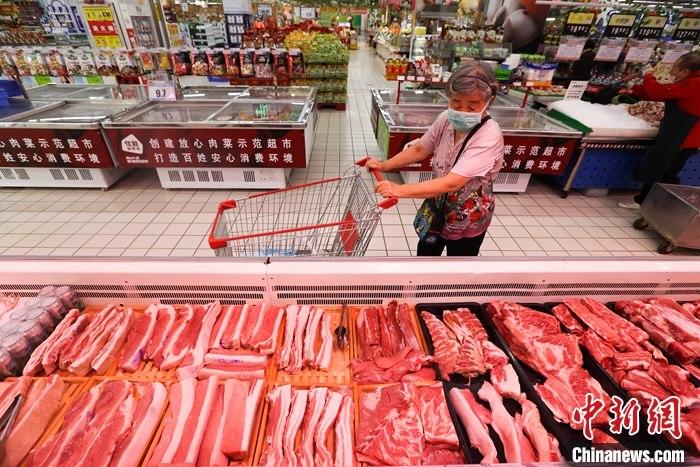China News Service, December 9th. The National Bureau of Statistics released on the 9th the national CPI (Consumer Price Index) and PPI (Industrial Producer Price Index) data for November.
During the interpretation, Dong Lijuan, senior statistician of the City Department of the National Bureau of Statistics, said that in November, the CPI fell month-on-month and year-on-year; in November, the prices of important livelihood commodities such as pork continued to fall.
At the same time, industrial production recovered steadily in November, market demand continued to pick up, and industrial product prices continued to rise.
Data map: A supermarket in Taiyuan City, Shanxi Province, citizens are buying pork.
Photo by China News Agency reporter Zhang Yun
Dong Lijuan said that in November, as all regions and departments continued to promote the "six stability" and "six guarantees", the prices of important livelihood commodities such as pork continued to fall.
From a month-on-month perspective, CPI fell by 0.6%.
Among them, food prices fell by 2.4%, which affected the CPI drop by about 0.53 percentage points.
In food, with the continuous recovery of live pig production, pork prices continued to fall by 6.5%, and the rate of decline narrowed by 0.5%; fresh vegetables and eggs were in sufficient supply, and prices fell by 5.7% and 1.6% respectively.
Non-food prices changed from a 0.1% increase last month to a decrease of 0.1%, which affected the CPI drop by approximately 0.09 percentage points.
Among non-food items, travel during the off-season was reduced, and the prices of air tickets, travel and hotel accommodation dropped by 15.6%, 4.4% and 3.4% respectively; new winter clothing products were launched, and clothing prices rose by 0.4%.
From a year-on-year perspective, CPI fell by 0.5% due to the high comparison base in the same period last year.
Among them, the price of food changed from a 2.2% increase last month to a decrease of 2.0%, which affected the CPI to drop by about 0.44 percentage points, which was the main reason for the CPI to change from rising to falling.
In food, the price of pork fell by 12.5%, an increase of 9.7 percentage points from the previous month, affecting the CPI drop by about 0.60 percentage points; the prices of eggs, chicken, and duck fell by 19.1%, 17.8% and 10.8%, respectively, with a widening range of decline; Vegetable prices rose 8.6%, a drop of 8.1 percentage points; fresh fruit prices rose 3.6%, an increase of 3.2 percentage points.
Non-food prices changed from flat last month to a decline of 0.1%, which affected the CPI drop by about 0.06 percentage points.
Among non-food, transportation and communications prices fell by 3.9%, of which gasoline and diesel prices fell by 17.9% and 19.6% respectively; medical care prices rose by 1.5%; education, culture, and entertainment prices rose by 1.0%.
The core CPI, excluding food and energy prices, continued to remain stable, up 0.5% year-on-year, the same rate of increase for 5 consecutive months.
According to estimates, in the 0.5% year-on-year decrease in November, the carry-over impact of last year's price changes was about 0, and the impact of new price increases was about -0.5 percentage points.
Dong Lijuan pointed out that in November, industrial production recovered steadily, market demand continued to pick up, and industrial product prices continued to rise.
From a month-on-month perspective, the PPI went from flat in the previous month to an increase of 0.5%.
Among them, the price of means of production rose by 0.7%, an increase of 0.6 percentage points from the previous month; the price of means of subsistence changed from a 0.1% drop in the previous month to an increase of 0.1%.
Among the 40 major industrial sectors surveyed, 24 had price increases, an increase of 12 over the previous month, and the increase reached 60%.
Affected by international crude oil prices and other factors, the prices of chemical raw materials and chemical products manufacturing increased by 2.2%, the prices of chemical fiber manufacturing increased by 1.9%, the prices of petroleum, coal and other fuel processing industries increased by 1.7%, and the prices of petroleum and natural gas extraction industries increased. 0.9%.
The demand for heating increased seasonally, and the prices of gas production and supply industries, coal mining and washing industries rose by 2.8% and 2.2% respectively.
The price of metal-related industries turned from falling to rising. The price of ferrous metal smelting and rolling processing industry increased by 1.5%, and the price of non-ferrous metal smelting and rolling processing industry increased by 1.1%.
In addition, the prices of non-metallic mineral products, paper and paper products, and textile industries rose by 0.7%, 0.5%, and 0.5%, respectively, all of which increased.
From a year-on-year perspective, PPI fell by 1.5%, and the rate of decline narrowed by 0.6 percentage points from the previous month.
Among them, the price of means of production fell by 1.8%, and the rate of decline narrowed by 0.9%; the price of means of subsistence fell by 0.8%, and the rate of decline expanded by 0.3%.
Among the major industries, the non-ferrous metal smelting and rolling processing industry, whose price increases increased by 4.1%, increased by 1.2 percentage points; the ferrous metal smelting and rolling processing industry, increased by 2.0%, or 1.7 percentage points.
The oil and natural gas mining industry, which decreased by 29.8%, decreased by 0.6%; the oil, coal and other fuel processing industries, decreased by 16.3%, and decreased by 2.2%; the manufacturing of chemical raw materials and chemical products decreased by 16.3%. 3.0%, a decrease of 3.0 percentage points; coal mining and washing industry, a decrease of 2.9%, a decrease of 2.6 percentage points.
According to estimates, among the 1.5% year-on-year decline in November, the carry-over impact of last year's price changes was about 0, and the impact of new price increases was about -1.5 percentage points.

